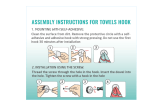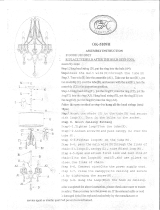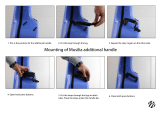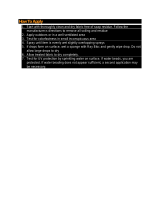Page is loading ...

1
Assembly and Operation InstructionsAssembly and Operation Instructions
BEFORE YOU BEGIN:
• Study the illustrations and sequence of assembly. The
sequence of assembly is important. Review the parts list
and become familiar with all parts before assembly. If any
parts are missing or damaged, contact RCS at 1-435-865-
7100 or email at [email protected]
• DO NOT MODIFY THE DESIGN OF THE ROCKET.
Changes to the design of the rocket such as, but not limited
to, reducing the fin size, shortening the body tube, or
modifying the motor tube assembly can adversely affect the
flight stability of the rocket.
• Only use AEROTECH™ Composite Model Rocket Motors
in this model rocket. See recommended AEROTECH™
motors chart on box label.
Motor adaptor tube (4-7/8"/124mm)(12421) 1
Adaptor rings (1/2"/13mm) (14001) 2
"E" spacer tube (2-1/8"/54mm) (14002) 1
Thrust ring (7/16"/11mm) (14010) 1
Thrust ring flange (1/16"/1.6mm) (14011) 1
Motor tube (12"/30.5cm) (12912) 1
Motor hook (19001) 1
FIN-LOK™ rings-3 fin (19343) 2
Centering rings (1-25/32"/46mm) (14829) 2
Fins (11710) 3
Cooling mesh (19011) 1
Ejection gas baffle (19030) 1
Screw eyes (19015) 2
ASSEMBLY INSTRUCTIONS:
MOTOR ADAPTOR
1. Lightly sand the motor adaptor tube and then slide an
adaptor ring onto the tube until the end of the ring is flush
with the end of the tube. This ring marks the front end of
the adaptor tube. Slide the other adaptor ring onto the
other end of the adaptor tube until the back edge of the
ring is 3/4" (19 mm) from the back end of the tube. Apply
beads of cement where the rings meet the adaptor tube.
2. Insert the "E" motor spacer tube into the motor adaptor
tube and position it at the front end of the adaptor tube. DO
NOT cement in place.
(Use medium viscosity cyanoacrylate cement.)
PARTS:
3/4"
19 mm
Motor
Adaptor
Tube
Adaptor
Rings
Cement
Bead
Cement
Bead
3/4"
19mm
Front
End
Shock cord (8'/2.4m) (17388) 1
Body tube (22-3/4"/58cm) (11924) 1
Payload bay tube (12"/305mm) (11912) 1
Bulkhead (1/16"/1.6mm) (14809) 1
Coupler tube (4"/102mm) (11804) 1
Launch lugs (19035) 2
Nose cone (11191) 1
Adhesive decal sheet (18013) 1
Parachute (22"/56cm diameter) (13022) 1
"F" spacer tube (1"/25mm) (14003) 1
Instructions (19913) 1
ADVANCED MODEL ROCKET
COMPLETED
ARREAUX™
ADVANCED
MODEL
ROCKET
Read And Follow
All Instructions
Designed by
Gary Rosenfield
™
Read and follow the Model Rocket Safety Code of the National Association of Rocketry
(NAR) and comply with all federal, state and local laws in all activities with model rockets.
19913-8091
Rev. 8/12/04
Division of RCS Rocket Motor Components, Inc.

2
NOTE: FROM THIS POINT ON, DO NOT USE ANY
CEMENT UNTIL REACHING ASSEMBLY STEP 5.
1. With their motor hook channels aligned with the motor
hook, slide a FIN-LOK™ ring and then an AERO-FI-
BRE™ centering ring over the front end of the motor
tube. Push on the centering ring until the back edge of the
FIN-LOK™ ring is moved to the forward most mark made
in Step 3 above. (NOTE: The rings are designed to be a
tight fit on the motor tube. If the rings are difficult to slide
onto the motor tube, round the inside edges of the rings
with sandpaper. If the FIN-LOK™ rings need to be turned
after they are on the motor tube, use a small piece of cloth
to provide a better grip.)
2. Slide the other FIN-LOK™ ring and then a centering ring
over the back end of the motor tube. Push on the
centering ring until the front edge of the FIN-LOK™ ring
is at the rear-most mark made in Step 3.
3. Using the line on the motor tube as a guide, gently twist the
back centering ring slightly until the fin locks of the back
FIN-LOK™ ring are aligned with the fin locks of the front
FIN-LOK™ ring.
from the back end of the motor tube. This mark locates
where the front edge of the rear most FIN-LOK™ ring will
be.
4. Insert the tab of the motor hook into the slot cut into the
motor tube. Use a small dowel to apply several drops
of cement around the inside of the motor tube just
behind where the motor hook comes through the
motor tube wall. Then, with the thrust ring flange facing
the back, insert the thrust ring assembly into the motor
tube. Use the motor adaptor to push the thrust ring
assembly forward until it stops against the tab of the motor
hook. Remove the motor adaptor.
4-5/8"
117 mm
Front Edge Of
Back FIN-LOK™
Ring
Back Edge Of
Motor Tube
Back Edge Of
Front FIN-LOK™
Ring
Motor
Hook
Slot
2-15/16"
75 mm
LOCATION
GUIDE
7/8"
22 mm
1/4"
6 mm
1/2"
13 mm
FIN-LOK™ ASSEMBLY
1. Cement the thrust ring flange (1/16"/1.6 mm thick) to the
thrust ring (7/16"/11 mm long). Set the thrust ring assem-
bly aside to dry.
2. Find the line drawn along the side of the motor tube. Using
the Location Guide printed along the top edge of this
instruction sheet, cut a 1/4" (6 mm) long slot 4-5/8"
(117mm) from the back end of the motor tube and next to
the line on the motor tube as shown.
3. Using the Location Guide, make a mark along the motor
tube line 2-15/16" (75 mm) from the back end of the motor
tube. This mark locates where the back edge of the front
FIN-LOK™ ring will be. Make another mark 7/8" (22 mm)
Thrust
Ring
Flange
Motor
Tube
Line
Thrust
Ring
MOTOR TUBE ASSEMBLY
Motor
Hook
Slot For
Motor
Hook
Front
End
FIN-LOK™Ring
Location Marks
AERO-FIBRE™
Centering
Ring
FIN-LOK™
Ring
Front
End
Motor
Hook
Channels
Motor
Tube
7/8"/22mm And 2-15/16"/75mm
From Back Edge Of Motor Tube
4-5/8"/117mm
From Back Edge Of
Motor Tube

3
FIN-LOK™ ASSEMBLY (CONT.)
LABYRINTH™ ASSEMBLY
Fin
Locks
Front
End
Cement
Beads
Front
Centering
Ring
Screw
Eye
Shock
Cord
Permanent
Cooling Mesh
(Stretch Out - 6")
Ejection Gas
Baffle
Shoulder
Baffle
Flange
Motor
Tube
1/4"/6mm
Cuts
DO NOT ALLOW CEMENT
TO GET IN THE FIN LOCKS
DO NOT CEMENT COOLING
MESH INTO MOTOR TUBE
1. Make four 1/4" (6mm) long cuts, 90 degrees apart, in the
front end of the motor tube.
2. Stretch out the cooling mesh to about 6" (15cm) in length.
Insert the cooling mesh into the front end of the motor
tube. (NOTE: Do not cement the mesh into the motor
tube.)
3. Apply a thin film of cement to the front 2/3rd's of the
shoulder of the ejection gas baffle and insert the baffle
shoulder all the way into the front end of the motor tube.
4. Apply beads of cement where the baffle meets the
motor tube and into each of the cuts in the motor tube.
5. Screw a screw eye all the way into the hole at the front end
of the baffle. Securely tie an end of the shock cord to the
screw eye with a square knot. (CAUTION: Do not put
cement on the knot of the shock cord. Cement will weaken
the shock cord.)
4. Test the proper positioning and alignment of the FIN-
LOK™ rings by snapping the fins into the fin locks. If any
fin does not snap into place, check to see that each FIN-
LOK™ ring is the correct distance from the back end of the
motor tube and that the fin has no plastic flashing left from
production that may be preventing a proper fit. Remove
any plastic flashing with a hobby knife or sandpaper. After
making any adjustments, carefully remove the fins and
the back centering ring. Check that the front centering
ring is still positioned next to and touching the front FIN-
LOK™ ring.
5. Apply a bead of cement where the front centering ring
meets the motor tube. Without getting cement into any of
the finlocks, apply cement only to the areas BETWEEN
the finlocks where the front FIN-LOK™ ring meets the
front centering ring and the motor tube.
6. Without getting cement into any of the fin locks, apply
cement only to the areas BETWEEN the fin locks where
only the front edge of the back FIN-LOK™ring meets the
motor tube. DO NOT apply cement to the back edge of the
back FIN-LOK™ ring. (NOTE: The unique AEROTECH
FIN-LOK™ fin mounting system carries and distributes
aerodynamic and thrust loads throughout an integrated
rocket structure in a manner found in large aerospace
vehicles. Loads are primarily borne by structural mem-
bers and not cement.)
7. Apply a bead of cement around the motor hook forward of
the front centering ring.

4
BODY AND FIN ASSEMBLY
Motor
Tube
Assembly
Fin
FIN-LOK™
Tab
Launch
Lug
Fin
Slot
Launch
Lug
Slot
Shock
Cord
Body
Tube
Fin
Root
PAYLOAD BAY ASSEMBLY
4. Cement the bulkhead to the end of the coupler tube.
5. Make a pencil mark 2" (51mm) from an end of the coupler
tube. Lightly sand the surface of the tube between the
mark and the bulkhead. Use a small dowel to apply a bead
of cement around the inside of the payload bay tube about
1" (25mm) from the end of the tube. Then slide the coupler
tube into the payload bay tube up to the pencil mark on the
coupler tube.
6. Wrap 1" (25mm) wide masking tape around the shoulder
of the nose cone until the nose cone fits snugly into the
forward end of the payload bay tube.
1. Paint the payload bay tube (12'/305mm long) and nose
cone black.
2. Screw the other screw eye all the way into the hole in the
bulkhead (1/16"/1.6mm thick). Apply a bead of cement
where the screw eye meets the bulkhead.
3. Pass the free end of the shock cord through the coupler
tube (4"/102mm long) and securely tie it to the screw eye
attached to the bulkhead with a square knot. (CAUTION:
Do not put cement on the knot of the shock cord. Cement
will weaken the shock cord.)
Coupler
Tube
Shock
Cord
Bulkhead
Payload
Bay Tube
Nose
Cone
Pencil
Mark
Screw
Eye
Nose
Cone
Shoulder
1. Using a hobby knife, carefully remove any body tube
material that may still be attached to any pre-cut slots in
the body tube.
2. Insert the loose end of the shock cord and then the motor
tube assembly into the back of the rocket body tube as
shown. Position the motor tube assembly so that the fin
locks are located under and visible through the body
tube's pre-cut fin slots.
3. Apply cement along the full length of the fin root of a fin
(area of the fin that makes contact with the outside surface
of the body tube). Carefully insert the fin through a slot in
the body tube and snap the fin into place. Repeat this
process for the other two fins. (NOTE: Each fin should be
snug against the body tube.)
4. Through the back end of the body tube, apply cement
where the fin tabs meet the motor tube, fin locks, front
centering ring and body tube. Through the front end of the
body tube, apply cement where the baffle flange meets
the inside surface of the body tube.
5. Lightly sand the surface of the body tube around the
launch lug slots. Apply cement to the base of a launch lug.
With the sloping portion of the launch lug toward the front
of the body tube, insert the tab on the bottom of the lug into
one of the pre-cut launch lug slots in the body tube.
Repeat this process for the other launch lug.
6. Paint the rocket body and fins yellow. (CAUTION: Make
sure the paint is compatible with high impact polystyrene
plastic.)

5
Shroud
Line
Loops
FINAL ASSEMBLY AND FINISHING
1. Slide the other centering ring over the back of the motor
tube and motor hook and push it against the back FIN-
LOK™ ring. Apply a bead of cement where the centering
ring meets the body tube.
2. Carefully cut out the self adhesive decals and apply them
to the rocket body and fins. See "Decal Instructions" for
helpful hints. Use the picture on page 1 as a guide to
proper positioning.
3. Fasten the fabric parachute to the shock cord at a point
about one (1) foot away from the payload bay in the
following manner. Stretch out the shroud lines of the
parachute so that the lines form three (3) loops on on top
of the other. Lay the shock cord across all the shroud
lines. pass the canopy of the parachute over the shock
cord and through the three (3) loops made by the shroud
lines and pull tight. Pack the parachute and insert the
payload bay into the body tube.
Shroud
Lines
Fabric
Parachute
Canopy
Nose
Cone
Self
Adhesive
Decals
Shock
Cord
Centering
Ring
DECAL INSTRUCTIONS
1. Handle the decal sheet carefully to avoid damage. Do not
crease the decal sheet.
2. Use a pair of sharp scissors or a hobby knife to cut out the
decals.
3. Cutting out decals that will be positioned close together
on the rocket as one block will make them easier to apply.
4. Make smooth cuts. Small knicks can cause a decal to
tear when it is being peeled off the backing sheet.
5. Before starting to peel decals off their backings, fill a soup
bowl with warm water and put one or two drops of a
dishwashing detergent into the water.
6. Carefully peel a decal off its backing, dip it into the
detergent solution and apply the decal to the rocket. The
detergent solution prevents the adhesive on the decal
from "grabbing" the rocket surface too quickly and allows
accurate positioning of the decal.
7. Gently press any air bubbles out from under the decal and
then dab the decal dry.
8. Apply the rest of the decals in the same manner.

6
OPERATION INSTRUCTIONS
1. RECOMMENDED MOTORS: Only use AEROTECH composite model
rocket motors when flying your AEROTECH rocket. See enclosed chart
for recommended motors and projected altitudes.
2. RECOVERY SYSTEM PREPARATION: Roll the parachute and shroud
lines, starting from the canopy peak, into a loose cylinder that will easily
slide into the lower body assembly body tube. Pack the long portion of the
shock cord into the body tube first. Next, insert the parachute. Finally,
insert the short length of shock cord into the body tube on top of the
parachute and put on the nose cone (or payload bay if your rocket has
one). Make sure that the parachute, shroud lines and shock cord are not
caught between the body tube and the shoulder of the nose cone or
payload bay. The nose cone or payload bay should slide freely. (NOTE:
Because your AEROTECH rocket has the LABYRINTH™ ejection gas
cooling system, no recovery wadding is required.)
3. MOTOR PREPARATION: The motors recommended for your AERO-
TECH rocket vary in physical size as well as performance. Your rocket
comes with a changeable motor adaptor and spacer tubes that permit the
the rocket to use each of the recommended motors without permanent
modification to the rocket.
Prepare your AEROTECH rocket motor according to the instructions that
come with the motor. Be sure the motor hook snaps in behind the nozzle
end of the motor and holds the motor securely in place. If the motor hook
does not hold the motor in place, bend the end of the hook until it does.
4. PRE-LAUNCH CHECKOUT: Before
EVERY flight, perform a complete
pre-launch checkout of your rocket;
• Check that all fins and launch lugs are mounted securely and not
damaged.
• Examine the body tube, nose cone and payload bay to make sure
they are free of damage.
• Check that the shock cord is securely mounted to the ejection gas
baffle and nose cone (or payload bay bulkhead).
• Check that the parachute is securely tied to the shock cord.
• Check that the shock cord and parachute are free of any damage.
• See that the nose cone (or payload bay), packed parachute and
shock cord move freely. After awhile, an ejection charge residue
may build up at the top inside surface of the body tube. Wipe this
residue away with isopropyl ("rubbing") alcohol.
• With the tail of the rocket pointed down and the motor tube empty,
shake the rocket to remove any loose ejection charge debris left
from a previous flight. Periodically, fluff up the cooling mesh using
a bent wire inserted through the back end of the motor tube.
• Be certain the motor to be used is a recommended AEROTECH
model rocket motor and of a size appropriate for the launch area.
• Be sure the motor hook, motor adaptor and motor tube are not
damaged and hold the motor securely in place.
If the pre-launch checkout reveals any damage, repair the damage
before the rocket is flown again.
5. LAUNCH PAD: Your AEROTECH rocket must be flown from a launch pad
with a 1/4"(6.4mm) diameter metal launch rod at least 36"(0.9m) long (as
measured from the top of the blast deflector), such as the AEROTECH
MANTIS™ model rocket launch pad.
6. MOTOR IGNITION: Only launch your rocket using a remotely controlled
and electrically operated launch controller such as the AEROTECH®
INTERLOCK™ model rocket launch controller. Keep yourself and all
other people at least 30 feet (10 meters) away from the rocket during
launch.
7. LAUNCH AREA: Launch the rocket in a cleared outdoor area free of tall
trees, power lines and buildings. The side dimensions of the cleared area
should be at least one half of the projected altitude. An area for a radius
of at least 5 feet (1.5 meters) from the launcher should be clear of dry grass
or other flammable substances. Read and follow the Model Rocket Safety
Code of the National Association of Rocketry (NAR) and comply with all
federal, state and local laws in all activities with model rockets. A copy of
the NAR safety code is shown on the instructions that come with all
AEROTECH composite model rocket motors.
8. FLIGHT PROFILE: When the launch button of the electrical launch
controller is pressed, an electrical current causes the AEROTECH COP-
PERHEAD™ single lead igniter to ignite the composite propellant of the
AEROTECH rocket motor. The motor quickly builds up thrust and powers
your AEROTECH rocket into the air. During powered flight the rocket
increases in speed and altitude. When the propellant burns out the rocket
is moving at maximum velocity and a time delay material (delay grain)
inside the motor burns. While the delay grain burns the rocket coasts to
peak altitude at which point the delay grain ignites the ejection charge
within the forward part of the motor. The ignition of the ejection charge
creates a burst of hot expanding gas which is cooled by the permanent
metal mesh of the LABYRINTH™ ejection gas cooling system. The
cooled gas flows around the baffle, pressurizes the parachute bay and
ejects the nose cone (or payload bay) and parachute. The parachute then
deploys and gently returns the rocket to the ground where the rocket can
be prepared for another flight.
9. TRANSPORT AND STORAGE: To avoid damage to your AEROTECH
rocket during transport, pack it in a box surrounded by soft packing. Store
your rocket at room temperature.
No warranty either expressed or implied is made regarding AeroTech/RCS products,
except for replacement or repair, at RCS’s option, of those products which are proven
to be defective in manufacture within one year from the date of original purchase. For
repair or replacement under this warranty, please contact RCS. Proof of purchase will
be required. Note: Your state may provide additional rights not covered by this warranty.
NOTICE: As we cannot control the storage and use of our products, once sold we cannot
assume any responsibility for product storage, transportation or usage. RCS shall not
be held responsible for any personal injury or property damage resulting from the
handling, storage or use of our product. The buyer assumes all risks and liabilities
therefrom and accepts and uses AeroTech/RCS products on these conditions.
AeroTech Division
RCS Rocket Motor Components, Inc.
Cedar City, UT 84720
www.aerotech-rocketry.com
Made in U.S.A.
©2004 RCS Rocket Motor Components, Inc., All rights reserved.
/




